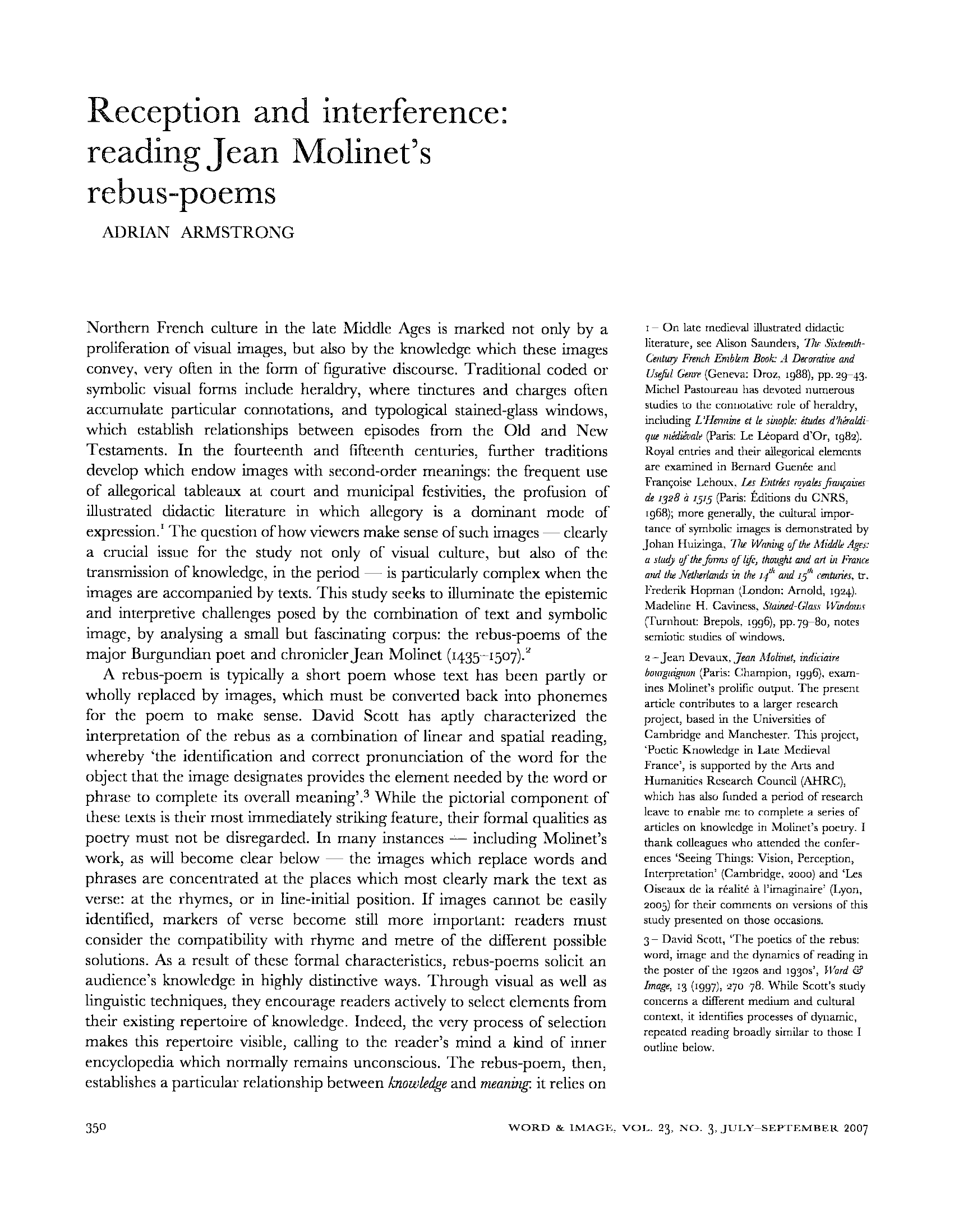Word & Image A Journal of Verbal/Visual Enquiry ISSN: 0266-6286 (Print) 1943-2178 (Online) Journal homepage: https://www.
Publié le 03/12/2019

Extrait du document
«
Reception and interference:
reading Jean Molinet's
rebus-poems
ADRIAN ARMSTRONG
Northern French culture in the late Middle Ages is marked not only by a
proliferation
of visual images, but also by the knowledge which these images
convey, velY often
in the form of figurative discourse.
Traditional coded or
symbolic visual fornls include heraldly, where tinctures and charges often
accumulate particular connotations,
and typological stained-glass windows,
which establish relationships between episodes from the Old and New
Testaments.
In the fourteenth ann fifteenth centuries, further traditions
develop which
endow images with second-order meanings: the frequent use
of allegorical tablealLx at court and municipal festivities, the profusion of
illustrated didactic literature in which allegory is a dominant mode of
expression.
I The question of how viewers make sense of such images -clearly
a crucial issue for
the study not only of visual culture, but also of the
transmission of knowledge, in the period - is particularly complex when the
images are accompanied by texts.
This study seeks to illuminate the epistemic
and interpretive challenges posed by the combination of text and symbolic
image,
by analysing a small but fascinating corpus: the rebus-poems of the
major Burgundian poet and chronicler Jean Molinet (I435-I507).2
A rebus-poem is typically a short poem whose text has been partly or
wholly replaced by images, which must be converted back into phonemes
for the poem to make sense.
David Scott has aptly characterized the
interpretation of the rebus as a combination of linear and spatial reading,
whereby 'the identification and correct pronunciation of the word for the
object that the image designates provides the element needed by the word or
phrase to complete its overall meaning'.3 While the pictorial component of
these texts is their must immediately striking feature, their formal qualities as
poetry must not be disregarded.
In many instances --'- including Molinet's
work, as will become clear below - the images which replace words and
phrases are concentrated at the places which most clearly mark the text as
verse:
at the rhymes, or in line-initial position.
If images cannot be easily
identified,
markers of verse become still more important: readers must
consider the compatibility with rhyme and metre of the different possible
solutions.
As a result of these formal characteristics, rebus-poems solicit an
audience's knowledge in highly distinctive ways.
Through visual as well as
linguistic techniques,
they encourage readers actively to select elements from
their existing repertoire of knowledge.
Indeed, the very process of selection
makes this
repertoire visible, calling to the reader's mind a kind of inner
encyclopedia which normally remains unconscious.
The rebus-poem, then,
establishes a particular relationship between knowledge and meaning: it relies on
I - On late medieval illustrated didactic
literature, see Alison Saunders, thr Sixteenth~ Century French Emblem Book: A Decoraliue and
Ustfol Genre (Geneva: Droz, 1988), pp.
2g- ..
3.
.Michel Pastoureau has devoted numerous
studies to the COIlllOlativc rule of heraldry,
including
L 'Hemline ct Ie sinople: etudes d'IzJraldi~
que mediival.
(Paris: Le Leopard d'Or, 1982).
Royal entries and their allegorical elements
are examined in Bernard Guenee and
Fran~oise Lehou:x, Les Entrks r~vales fimlfaises
cle 1328 a 1515 (Paris: Editions du CNRS, 1968); more generally, the cultural impor~ tance of sym bolic images is demonstrated by
Johan Huizinga, 77ll Waning of the Middk Ages: a sludy r!l the jimns of lift, thought and art in Frallce
and tlze Netherlands in the J/' and 15'" centuries, tr.
Frederik Hopman (London: Arnold, 192+).
Madeline H.
Caviness, Slai.ned~(;la.Is Windows
(Turnhou!: Brepols, 1996), PP.7g-80, notes
semiotic studies of windows.
2 -
Jean Devaux, Jean Afo/i1let, indiciai" bOll1guZl;IWIl (Paris: Champion, 1996), exam~ ines Moline!'s prolific output.
The present article contributes to a larger research
project, based in the Universities of
Cambridge and Manchester.
This project,
'Poetic Knowledge in Late Medieval
France', is supported by the Arts and
Humanities Research Council (AHRC),
which has also funded a period of research
leave to enable me to complete a series of
articles on knowledge in Moline!'s poetry.
I thank colleagues who attended the confer~
ences 'Seeing Things: Vision, Perception, Interpretation' (Cambridge, 2000) and 'Les
OisealiX de la n'alite it l'imaginaire' (Lyon,
2005) for their comments on versions
of this
study presented on those occasions.
3 -
David Scott, 'The poetics of the rebus:
word, image
and the dyoarnics of reading in the poster of the 1920S and 193os', ~I'ord &
Image, 13 (1997), 270 .78.
While Scott's study
concerns a different medium and cultural
context, it identifies processes
of dynamic, repeated reading broadly similar to those I
outline below.
350 WORD & U ...
1AGE.
VOL.
23.
N0.3.
JULY-SEPTEMBER 2007.
»
↓↓↓ APERÇU DU DOCUMENT ↓↓↓
Liens utiles
- ?https://www.larousse.fr/encyclopedie/divers/révolution_française_de_1848/140734 https://geoffreyhistoire.pagesperso-orange.fr/monarchiejuillet.html http://lesdefinitions.fr/discours http://www.toupie.org/Dictionnaire/Suffrage_universel.htm https://www.napoleon.org/histoire-des-2-empires/chronologies/du-consulat-a-vie-a-lempire-hereditaire-1802-1804/ « Il y a plus de
- https://www.
- ?https://www.youtube.com/watch?v=KPROPun3Rd8 Expose seconde guerre mondiale : Bonjour, aujourd?hui nous allons tentez
- MILLERAND, Alexandre (10 novembre 1859-6 avril 1943) Président de la République (1920-1924) C'est auprès de Clemenceau, lorsqu'il travaille au journal La Justice, que Millerand commence sa carrière politique.
- MILLERAND, Alexandre (10 novembre 1859-6 avril 1943) Président de la République (1920-1924) C'est auprès de Clemenceau, lorsqu'il travaille au journal La Justice, que Millerand commence sa carrière politique.

































